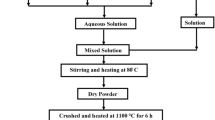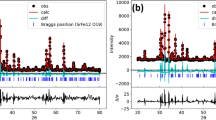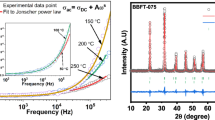Abstract
Solid solutions were obtained on the basis of (Na,Li)NbO3 binary system, modified by addition of minor amount (not greater than 5 wt%) of various elements’ monoxides, including their combinations. This study focuses on the peculiar features of their crystalline structure, grain structure, and thermal-frequency behavior of relative permittivity. The modifications by simple Mn and Cu oxides demonstrate a retention of crystalline structure of initial solid solution. Addition of NiO leads to transformation of phase state, which is stipulated by high stereochemistry activity and emission ability of Ni(II). A noticeable variation of phase state occurs also due to the combined modification by the above-mentioned oxides and Bi2O3+Fe2O3 ones. It is established that high-temperature anomalies of dielectric properties are related to partial reduction of niobium. It was also shown that the given modified lead-free solid solutions are characterized with improved piezoelectric, ferroelastic, and mechanical properties, and they can be applied in the field of microwave engineering.








Similar content being viewed by others
References
Zhang S, Xia R, Shrout TR (2007) Lead-free piezoelectric ceramics vs. PZT? J Electroceram 19:251–257. doi:10.1007/s10832-007-9056-z
Lin D, Xiao D, Zhu J et al (2004) Synthesis and piezoelectric properties of lead-free piezoelectric [Bi0.5(Na1−x−yKxLiy)0.5]TiO3 ceramics. Mater Lett 58:615–618. doi:10.1016/S0167-577X(03)00580-9
Guo Y, Kakimoto K, Ohsato H (2005) (Na0.5K0.5)NbO3–LiTaO3 lead-free piezoelectric ceramics. Mater Lett 59:241–244. doi:10.1016/j.matlet.2004.07.057
Mitra S, Kulkarni AR, Prakash O (2013) Diffuse phase transition and electrical properties of lead-free piezoelectric (LixNa1−x)NbO3 (0.04 ≤ x ≤ 0.20) ceramics near morphotropic phase boundary. J Appl Phys 114:064106. doi:10.1063/1.4817815
Li J-F, Wang K, Zhu F-Y et al (2013) (K,Na)NbO3—Based lead-free piezoceramics: fundamental aspects, processing technologies, and remaining challenges. J Am Ceram Soc 96:3677–3696. doi:10.1111/jace.12715
Kravchenko OY, Reznichenko LA, Gadzhiev GG et al (2008) Properties of Na0.875Li0.125NbO3 ceramics. Inorg Mater 44:1135–1150. doi:10.1134/S002016850810021X
Directive 2011/65/EU of the European Parliament and of the Council (2011) on the restriction of the use of certain hazardous substances in electrical and electronic equipment. Off J Eur Union 54:88–110. doi:10.3000/17252555.L_2011.174.eng
Zhang S-T, Kounga AB, Aulbach E et al (2008) Lead-free piezoceramics with giant strain in the system Bi0.5Na0.5TiO3–BaTiO3–K0.5Na 0.5NbO3. I. Structure and room temperature properties. J Appl Phys 103:034107. doi:10.1063/1.2838472
Shen Z-Y, Zhen Y, Wang K, Li J-F (2009) Influence of sintering temperature on grain growth and phase structure of compositionally optimized high-performance Li/Ta-modified (Na,K)NbO3 ceramics. J Am Ceram Soc 92:1748–1752. doi:10.1111/j.1551-2916.2009.03128.x
Lévêque G, Marchet P, Levassort F et al (2011) Lead free (Li, Na, K)(Nb, Ta, Sb)O3 piezoelectric ceramics: influence of sintering atmosphere and ZrO2 doping on densification, microstructure and piezoelectric properties. J Eur Ceram Soc 31:577–588. doi:10.1016/j.jeurceramsoc.2010.10.031
Gao Y, Zhang J, Qing Y et al (2011) Remarkably strong piezoelectricity of lead-free (K0.45Na0.55)0.98Li0.02(Nb0.77Ta0.18Sb0.05)O3 ceramic. J Am Ceram Soc 94:2968–2973. doi:10.1111/j.1551-2916.2011.04468.x
Qin Y, Zhang J, Tan Y et al (2014) Domain configuration and piezoelectric properties of (K0.50Na0.50)1−xLix(Nb0.80Ta0.20)O3 ceramics. J Eur Ceram Soc 34:4177–4184. doi:10.1016/j.jeurceramsoc.2014.07.026
Wu DW, Chen RM, Zhou QF et al (2009) Lead-free KNLNT piezoelectric ceramics for high-frequency ultrasonic transducer application. Ultrasonics 49:395–398. doi:10.1016/j.ultras.2008.11.003
Chang RC, Chu SY, Lin YF et al (2007) An investigation of (Na0.5K0.5)NbO3-CaTiO3 based lead-free ceramics and surface acoustic wave devices. J Eur Ceram Soc 27:4453–4460. doi:10.1016/j.jeurceramsoc.2007.02.218
Chang R-C, Chu S-Y, Wong Y-P et al (2007) Properties of (Na0.5K0.5)NbO3–SrTiO3 based lead-free ceramics and surface acoustic wave devices. Sens Actuators A 136:267–272. doi:10.1016/j.sna.2006.11.002
Dantsiger AY, Razumovskaya ON, Reznichenko LA et al (2001) Multicomponent systems of ferroelectric complex oxides: physics, crystal chemistry technology. Aspects of the design of active materials. Rostov State University, Rostov-on-Don
Lin D, Zheng Q, Kwok KW et al (2010) Dielectric and piezoelectric properties of MnO2-doped K0.5Na0.5Nb0.92Sb0.08O3 lead-free ceramics. J Mater Sci 21:649–655. doi:10.1007/s10854-009-9971-7
Azough F, Wegrzyn M, Freer R et al (2011) Microstructure and piezoelectric properties of CuO added (K, Na, Li)NbO3 lead-free piezoelectric ceramics. J Eur Ceram Soc 31:569–576. doi:10.1016/j.jeurceramsoc.2010.10.033
Zhao P, Zhang B-P, Li J-F (2007) High piezoelectric d33 coefficient in Li-modified lead-free (Na, K)NbO3ceramics sintered at optimal temperature. Appl Phys Lett 90:242909. doi:10.1063/1.2748088
Wu W, Chen M, Ding Y, Liu Ch (2014) Phase structure and electrical properties of Yb and Mn co-substituted (K0.48Na0.52)NbO3 lead-free piezoelectric ceramics. J Alloys Compd 588:496–501. doi:10.1016/j.jallcom.2013.11.057
Du H, Ya Huang, Tang H et al (2013) Dielectric and piezoelectric properties of SrZrO3−modified (K0.45Na0.51Li0.04)(Nb0.90Ta0.04Sb0.06)O3 lead-free piezoceramics. Mater Lett 106:141–144. doi:10.1016/j.matlet.2013.04.052
Liu Ch, Xiao D, Huang T et al (2014) Composition induced rhombohedral–tetragonal phase boundary in BaZrO3 modified (K0.445Na0.50Li0.055)NbO3 lead-freeceramics. Mater Lett 120:275–278. doi:10.1016/j.matlet.2014.01.096
Zhou J, Ma Q, Wang P et al (2014) Influence of rare-earth Nd, Dy, and Ho doping on structural and electrical properties of (Na0.53K0.47)0.942Li0.058NbO3 based lead-free piezoceramics. Ceram Int 40B:2451–2459. doi:10.1016/j.ceramint.2013.08.020
Rai R, Rani R, Sharma S, Kholkin AL (2013) Influence of Li and La content on phase structures and electrical properties of K0.5Na0.5NbO3 lead-free piezoelectric ceramics. J Alloys Compd 577:575–580. doi:10.1016/j.jallcom.2013.06.139
Jia Y, Wei Y, Wu Zh et al (2014) Effects of compositional changes on luminescence of lead-free Eu3+-doped K1−xNaxNbO3 piezoelectric ceramics. J Alloys Compd 586:66–68. doi:10.1016/j.jallcom.2013.10.032
Taub J, Ramajo L, Castro MS (2013) Phase structure and piezoelectric properties of Ca- and Ba-doped K1/2Na1/2NbO3 lead-free ceramics. Ceram Int 39:3555–3561. doi:10.1016/j.ceramint.2012.10.181
Bafandeh MR, Gharahkhani R, Lee J-Sh (2014) Enhanced electric field induced strain in SrTiO3 modified (K, Na)NbO3-based piezoceramics. J Alloys Compd 602:285–289. doi:10.1016/j.ceramint.2014.05.070
Lu Sh, Xu Zh, Zuo R (2014) Comparative study of the effect of domain structures on piezoelectric properties in three typical Pb-free piezoceramics. Ceram Int 40:13565–13571. doi:10.1016/j.ceramint.2014.05.070
Fesenko EG (1972) Perovskite family and ferroelectricity. Atomizdat, Moscow
Umanskii YS (1969) X-ray analysis of metals and semiconductors. Metallurgia, Moscow
IEEE Standard on piezoelectricity (1988). doi:10.1109/IEEESTD.1988.79638
Okazaki K (1969) Ceramic engineering for dielectrics. Zinatne, Tokio
Razumovskaya ON, Devlikanova RU, Belyaev IN, Tokmyanina TB (1976) Thermogravimetric analysis of Pb2NbMnO6 and Pb2WMnO6. Izv RAN USSR. Neorg Mater 12:471–474
Reznichenko LA, Shilkina LA, Gagarina ES et al (2004) Crystallographic shear in niobium oxides of different compositions. Crystallogr Rep 49:820–827. doi:10.1134/1.1803313
Rao CNR, Gopalakrishnan J (1997) New direction in solids state chemistry. Cambridge University Press, Cambridge
Ginier A (1961) X-ray analysis of crystals. Publishing House of Physics and Mathematics, Moscow
Cotton FA, Wilkinson G (1962) Advanced inorganic chemistry. Interscience Publishers, New York
Mandelkorn L (1971) Non-stoichiometric compounds. Khimia, Moscow
Ormont BF (1982) Introduction into physical chemistry and crystal chemistry of semiconductors. Vysshaya Shkola, Moscow
Narai-Sabo I (1969) Inorganic crystal chemistry. Academy of Sciences of Hungary, Budapest
Nikolskii BP, Grigorov ON, Pozin ME (1963) Guidebook of chemist. Main properties of inorganic and organic compounds. State R&D publishing house of chemical literature, Moscow-Leningrad
Stromberg AG, Semchenko DP (1974) Physical chemistry. Vysshaya Shkola, Moscow
Liu Y, Huang Y, Du H et al (2010) Crystal structure and properties of K0.5Na0.5NbO3–Bi0.5Na0.5TiO3–LiSbO3 lead-free piezoelectric ceramics. J Alloys Compd 506:407–411. doi:10.1016/j.jallcom.2010.07.017
Wang Y, Qibin L, Zhao F (2010) Phase transition behavior and electrical properties of [(K0.50Na0.50)1−xAgx](Nb1−xTax)O3 lead-free ceramics. J Alloys Compd 489:175–178. doi:10.1016/j.jallcom.2009.09.047
Du H, Tang F, Luo F et al (2007) Influence of sintering temperature on piezoelectric properties of (K0.5Na0.5)NbO3–LiNbO3 lead-free piezoelectric ceramics. Mater Res Bull 42:1594–1601. doi:10.1016/j.materresbull.2006.11.043
Xu C, Lin D, Kwok KW (2008) Electrical properties of (K0.5Na0.5)1−x AgxNbO3 lead-free piezoelectric ceramics. J Mater Sci Mater Electron 19:1054–1057. doi:10.1007/s10854-007-9458-3
Reznichenko LA, Dantsiger AY, Razumovskaya ON et al (2000) Ferroelectric elastance of sodium niobate–lithium niobate solid solutions in relation to A–O bond covalence. Tech Phys 45:1437–1440. doi:10.1134/1.1325026
Fesenko EG, Dantsiger AY, Razumovskaya ON (1983) New piezoceramic materials. Publishing House of Rostov State University, Rostov-on-Don
Povarennykh AS (1962) On application of electronegativeness of elements in crystal chemistry and mineralogy. Part 1. AN UkrSSR, Kiev
Dantsiger AY, Borodin VZ, Reznitchenko LA et al (2000) The effect of space charge and crystallite size on the formation of properties of ferropiezoceramic materials. Tech Phys 45:563–565. doi:10.1134/1.1259677
Skulski R, Dudek J, Kupryianov MF (1997) The investigations of the R3c R3m phase transition in Pzt-Type ceramics. correlation with ordering effects. Ferroelectrics 192:339–344. doi:10.1080/00150199708216209
Vezzoli GC (1982) Electrical properties of NbO2 and Nb2O5 at elevated temperature in air and flowing argon. Phys Rev B 26:3954–3957. doi:10.1103/PhysRevB.26.3954
Reznichenko LA, Shilkina LA, Gagarina ES et al (2003) Structural instabilities, incommensurate modulations and P and Q phases in sodium niobate in the temperature range 300–500 K. Crystallogr Rep 48:448–456. doi:10.1134/1.1578130
Reznichenko LA, Akhnazarova VV, Shilkina LA et al (2009) Invar effect in n-Nb2O5, αht-Nb2O5, and L-Nb2O5. Crystallogr Rep 54:483–491. doi:10.1134/S1063774509030183
Acknowledgements
The analytic experiments for this work have been performed on the equipment provided by the Collective use center “Electromagnetic, electromechanical and thermal properties of solids” of the Research Institute of Physics, Southern Federal University. This work was supported by the Ministry of Science and Education of Russian Federation, under the grant of the President of Russian Federation number MK-3232.2015.2; under the State Task project numbers 1927 (213.01-11/2014-21), 3.1246.2014/К (213.01-11/2014-66PCh), 213.01-2014/012-VG; and the Southern Federal University, Order No17738 from 18.12.2015.
Author information
Authors and Affiliations
Corresponding author
Rights and permissions
About this article
Cite this article
Abubakarov, A.G., Pavelko, A.A., Sadykov, K.A. et al. Influence of CuO, MnO2, NiO, Bi2O3, and Fe2O3 modifiers on the crystalline structure and electrophysical properties of (Na,Li)NbO3 solid solutions. J Mater Sci 52, 2142–2157 (2017). https://doi.org/10.1007/s10853-016-0502-7
Received:
Accepted:
Published:
Issue Date:
DOI: https://doi.org/10.1007/s10853-016-0502-7




